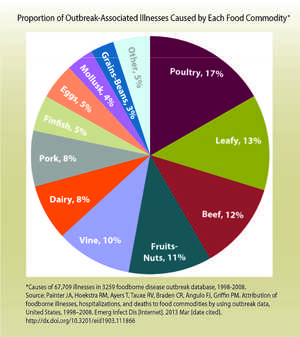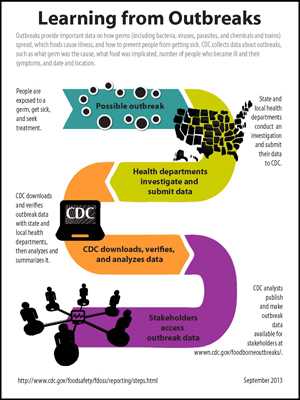Reporting Foodborne Outbreaks
Foodborne Disease Outbreaks & National Outbreak Reporting System (NORS)
State, local, and territorial public health agencies report outbreaks to the Foodborne Disease Outbreak Surveillance System using the National Outbreak Reporting System (NORS).
Through NORS, CDC collects reports of enteric disease outbreaks caused by bacterial, viral, parasitic, chemical, toxin, and unknown agents, as well as waterborne outbreaks of non-enteric disease.
The system collects information such as date and location of the outbreak, the number of people who became ill and their symptoms, the food implicated in the outbreak, where the food was prepared and eaten, and the pathogen that caused the outbreak.1
Improved Reporting of Outbreaks
What Are Enteric Illnesses?
Enteric illnesses are characterized by symptoms such as diarrhea, nausea, or vomiting. Some microbes such as E. coli cause enteric illness and may also cause other types of symptoms or conditions, such as hemolytic uremic syndrome, or HUS.2
National foodborne and waterborne disease outbreak surveillance has been a core function of CDC since the 1970s.2 Two surveillance systems handle this responsibility: the Waterborne Disease and Outbreak Surveillance System (1971-present) and the Foodborne Disease Outbreak Surveillance System (1973-present). (View milestones [PDF – 1 page] of the Foodborne Disease Outbreak Surveillance System).
Foodborne disease outbreak data have been collected electronically since 1998. CDC launched NORS in 2009 as a web-based platform into which health departments enter outbreak information. NORS was designed to integrate and enhance outbreak reporting systems with new components beyond food and waterborne disease outbreaks.
NORS collects data on these types of outbreaks in the United States:
- Waterborne disease outbreaks – all outbreaks of respiratory, skin, enteric or other types of illness spread primarily through water, including water that people drink, swim in, or use for other purposes
- Foodborne disease outbreaks – all outbreaks of enteric illness spread through food
- Person-to-person transmitted disease outbreaks – all outbreaks of enteric illness spread directly from one person to another through direct contact, such as by handshake or kissing
- Animal contact disease outbreaks – all outbreaks of enteric illness spread to humans from contact with animals, such as a pet turtle or frog, or their environments
- Environmental contamination outbreaks – all outbreaks of enteric illness spread through contact with other environmental sources, such as dirty linens or surfaces that people touch in bathrooms.
- Other enteric illness outbreaks – all outbreaks of enteric illness spread through other or unknown means (Learn more about NORS.)
Related Links
- Foodborne Outbreak Investigation Toolkit
- National Outbreak Reporting System (NORS): About NORS
- National Outbreak Reporting System (NORS):NORS: Training – Foodborne Outbreaks
- National Outbreak Reporting System (NORS): NORS: Forms and Guidance – Foodborne Outbreaks
- National Outbreak Reporting System (NORS): Analyzing NORS Data
- Tracking and Reporting Foodborne Disease Outbreaks
- Investigating Foodborne Outbreaks
- Steps in a Foodborne Outbreak Investigation
- How to Report a Foodborne Illness
References
- CDC. FOOD Tool Questions and Answers
- CDC. About NORS
- Page last reviewed: November 2, 2015
- Page last updated: November 2, 2015
- Content source:


 ShareCompartir
ShareCompartir

